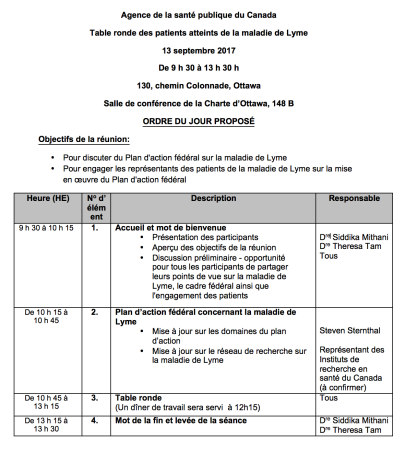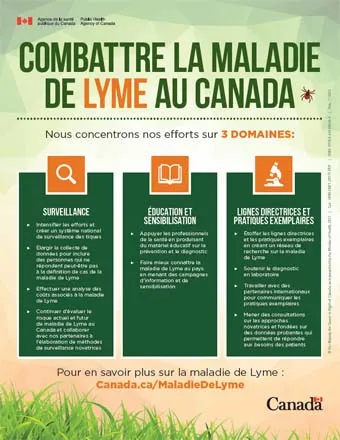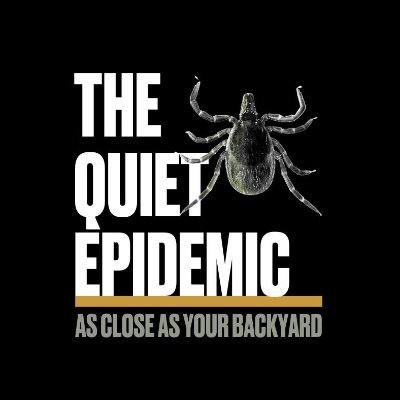27
Sep
2017
PHAC roundtable with patient groups

On September 13, 2017, at the offices of the Public Health Agency of Canada (PHAC), a roundtable discussion was held with Lyme disease patient representatives from Canada and senior PHAC executives.
The 4-hour meeting was chaired by Dr. Siddika Mithani, President of the Public Health Agency of Canada, accompanied by Dr. Theresa Tam, Chief Public Health Officer of Canada, and Dr. Howard Njoo, Deputy Chief Public Health Officer of Canada. Steven Sternthal, PHAC Director General of the Centre for Foodborne, Environmental and Zoonotic Infectious Diseases, was also in attendance, as were representatives from the Canadian Institute of Health Research, who came to present details of the new Lyme disease research network announced in May 2017 by then Health Minister Philpott.
The national and provincial patient representatives present were :

- Jim Wilson (CanLyme)
- Jennifer Kravis (LymeHope)
- Dr Ted Cormode (Victoria Lyme Awareness and Support Group, British Columbia)
- Krista Robertson (Lyme Disease Association of Alberta)
- Triant Steuart (Saskatchewan Lyme Disease Association)
- Marnie LePage (Manitoba Lyme Tick-borne illness)
- Lesley Fleming (Lyme Disease Society of Canada, VOCAL Ottawa, Ontario)
- Linda Kelso (Ontario Lyme Alliance)
- Ellen Hohs (Lyme Ontario)
- Marguerite Glazer (Association québécoise de la maladie de Lyme)
- Donna Lugar (Maritimes and Atlantic Lyme Disease)
- Janet Higgins (Lyme NB, New Brunswick)
The patient representatives had met several times by teleconference in preparation for the meeting with PHAC, and we arrived united and well-prepared, with several documents of questions, claims and facts.
The agenda for the meeting had been distributed to us in advance, and included a few questions under the sections monitoring, education and awareness, and guidelines and best practices, the three pillars of the federal framework tabled earlier this year. We took the time to present our responses (in English) before the meeting and we also submitted a short list of nos propres questions (en anglais) pour l’Agence, qui sont majoritairement restées sans réponse. Nous avons aussi reçu, en personne, the presentation that would guide the round table.
At the very start of the meeting, PHAC President Dr. Mithani took the time to read 3 letters from the campaign that had particularly touched her. Lyme Letters from LymeHope in which several Quebecers took part. She was visibly touched and disturbed by what she had read, and it was with emotion that she promised to move this issue forward quickly for the well-being of Canadians.
We thanked PHAC for their collaboration and communicated our desire to work with them to move things forward, to put our differences aside since what matters most are the lives of Canadians at stake (Jennifer Kravis of LymeHope read this introductory letter). There was great unity among patient representatives, who have very similar priorities and vision across the country, and we have a solid foundation to work from.

Although the federal Lyme disease framework did not reflect the patient voice and was a major disappointment, there is no question of revisiting it at this time. Instead, PHAC is moving towards an Action Plan based on the framework, i.e. the implementation of concrete steps. We’ve asked repeatedly to see the creation of a formal oversight committee for future actions, made up of doctors, scientists, patient group representatives, actual disease experts from across the country, public health representatives, etc. They’ve agreed on a framework for action, and we’re moving forward with it. They agreed to set up such a committee.
We’ve made it clear that we represent patients, and that we’re facing a real health crisis. It is critical to offer recognition and concrete help to patients who are sick now and who are not being taken care of, and to
prévenir les nouveaux cas de façon adéquate pour éviter des problèmes de santé de longue durée. Bien qu’ils soient compatissants envers la situation, cette problématique ne pourra pas être réglée du jour au lendemain. Les représentants de patients sont tous d’accord que nous allons pousser ce point le plus possible dans toute rencontre et intervention à venir, car pour nous c’est la priorité numéro un.
We spent the vast majority of the meeting going over, one by one, the issues surrounding Lyme disease in Canada. It was a long list, I assure you! In an incomplete summary, we talked about :
- using the ILADS guidelines, that the 2006 IDSA guidelines should no longer be supported;
- conflicts of interest within PHAC, especially as 2 of the people present are infectious diseases physicians;
- encourage ongoing, relevant education of physicians based on recent science (not just erythema migrans, acute phase);
- encouraging doctors to develop expertise in the field and to practice freely; to clarify that the definition of Lyme disease surveillance on the PHAC website does not constitute a basis for diagnosis, on which point they have undertaken to clarify the information shared on the Agency’s website;
- taking into account all the financial injustices of loss of income with no compensation, no payment of disability bonuses, no fair recognition of health status in the country (no diagnostic code);
- the need for better tests (e.g. ELISPOT and ELISA C6 together), to disclose Western Blot strips to physicians;
- the need to be able to make a clinical diagnosis at every stage of the disease, based on signs and above all symptoms, which are often invisible;
- that it takes far too long to find out if a tick is infected;
- that the attachment time does not have to be a minimum of 24 hours, nor that 70-80% of people have classic erythema migrans;
- working with First Nations populations;
- talking to medical organizations across the country to educate them and make sure they pass on factual information to their members;
- the problems of co-infections, which are not taken into account;
- ticks that don’t have black legs, but which also make you sick;
- creating links with veterinarians familiar with Lyme disease, to help with surveillance;
- the need to include out-of-protocol infections in national and provincial statistics, etc.
I’m skipping some, but if you can think of it, it’s probably been said!
Dr. Mithani asked if there was any progress in the provinces that we could build on, and Manitoba and Ontario explained that they were in regular contact with their health ministries and that they were moving things forward slowly but surely. She pledged to facilitate a dialogue between provincial patient groups and the respective provincial ministries of health, and that they would study the successes in Manitoba and Ontario to help us replicate them in other provinces.
First of all, PHAC wants to focus on the next 6 months and put in place actions with concrete measurable goals. The priorities are surveillance, education and awareness, and while these aren’t necessarily the areas we’d like to focus on in their current form, there will be scope to influence action there for the benefit of patients and the public. We want to move forward where there is already a form of consensus to develop a relationship of trust.
As for the Lyme disease research network, they spent some time giving us an update on the CIHR Lyme disease research network. We pointed out that $4 million is a small amount for the pressing needs in this area. In addition, we expressed our dissatisfaction at having been excluded from this process until now, apart from the recent communication of the network’s pre-announcement, and reiterated our desire to be involved. PHAC pledged to create a peer review committee to oversee spending of the $4 million research fund, and to act with transparency, perhaps even including patients. Note that the pre-announcement for this fund states that: “Applications must include a patient engagement plan. The evaluation process will involve patients and patient engagement experts, as well as other stakeholders. Patients will be expected to play a role in the governance of the network”, and we will ensure that these commitments are met, and that the patient cohort presents a true picture of reality, and not just official reported cases.
The senior PHAC executives present committed to continuing to consult all stakeholders, including patient representatives and their medical and scientific experts, in regular discussions over several years. They will shortly be establishing a roadmap and specific dates. We are currently awaiting their notes on our meeting, which the AQML will share with you, and will forward our recommendations to them at that time. We left the meeting with the hope that concrete action will soon be taken to improve the deplorable situation of Lyme disease in Canada (and Quebec, of course!), and that we will quickly establish a partnership with the PHAC to get on board with all the necessary issues.



